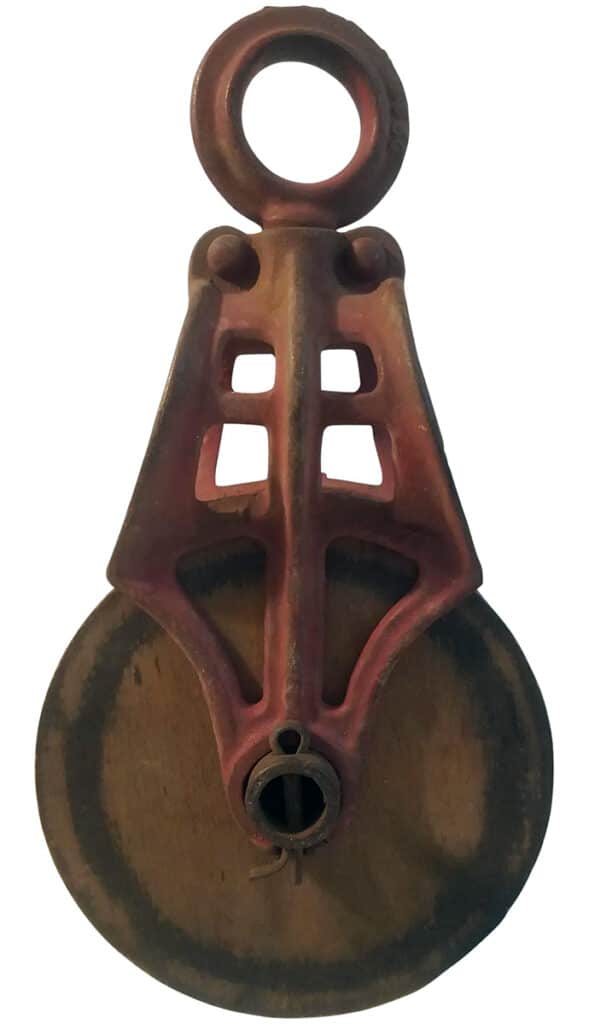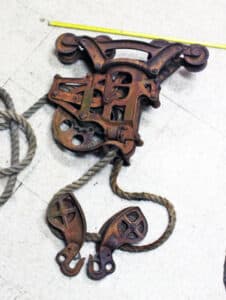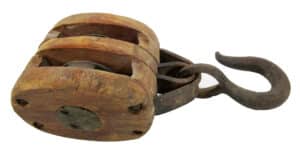by Jessica Kosinski

If you love the look and feel of old-fashioned barns, you are not alone. Many people love barn-related collectibles. Antique barn pulleys are near the top of the list of popular barn items. The largest collection of them in the United States is housed at a specialty museum in South Dakota, but you don’t have to start a museum to be a barn pulley collector. Collecting just a few of them can help you recreate the feel of an old barn, and they even serve several useful purposes. Here are some fun facts and history about antique pulleys.
Pulleys Have Many Names
You may have heard pulleys called by different names in the past. Some other names for them include blocks and sheaves. Technically, sheaves are specifically the round portions of the pulleys that turn as ropes are pulled over them. The term “block and tackle” refers to a pair or group of pulleys attached to each other with wire or rope.
Pulleys Are Ancient and Versatile Tools
You may think of pulleys as integral parts of early American barns, and they were. Pulleys were necessary to help farmers hoist hay up into barn lofts for storage. What you may not realize is these pulleys were popular in many other places for various purposes around the same time. Most notably, pulleys were commonly used on boats. They were used to load and unload cargo, as well as lifeboats. Many ships also used them to control sails.
The use of the pulley is not limited to the U.S. Pulleys also did not originate in barns. The Ancient Mesopotamian civilization is the earliest known group to have used pulleys, based on written records. However, they may have existed in some form even earlier than 1500 B.C.E., which was when their use was recorded in Mesopotamia. The Ancient Egyptians also famously used pulleys for many purposes. There is speculation that they may have even constructed the pyramids using pulley systems.
The Science Behind Pulleys and Development of the Block and Tackle System
A pulley is simply a wheel with a rope pulled over it. It allows you to reverse the direction of the force on a rope. Pulleys are useful because they cut down the amount of effort and time it takes to move various materials. Block and tackle pulley systems combine more than one pulley. The famous Greek inventor, Archimedes, is widely credited with inventing the multi-pulley system.
In terms of early American barns, the use of multiple pulleys at one time revolutionized things like hay and grain storage. The more pulleys are working together, the less effort it takes to move items. Therefore, those systems made work far easier and faster for farmers.
Barn Pulley Materials
If you want to start a barn pulley collection, you need to begin with an understanding of the types of barn pulleys available and the materials out of which they are made. Antique barn
pulleys typically consisted of one or more of a few specific materials. Those materials were wood, cast iron, and steel. Often, wood wheels or sheaves were surrounded by cast iron.
Sometimes, both the sheaves and their surroundings were made from solid steel.
Popular Antique Barn Pulley Makers

The makers of most antique barn pulleys are not easily identifiable. In some cases, they cannot be identified at all. However, there are a couple of popular antique barn pulley makers. One is the Starline company. Sometimes Starline pulleys include images of stars on them. The Starline company originated in Illinois as a company called Hunt, Helm, Ferris, and Company in 1883. It was renamed Starline in 1931.
Another popular antique pulley maker was F.E. Myers and Co. Myers went into business selling farm equipment from Ashland, Ohio in 1870 with his brother, Philip. Initially, the pair was known more for producing water pumps. They even had an exhibition of their pumps in 1882 at the Ohio State Fair. However, by 1902 the company had produced more than 260,000 pulleys.
The Louden Machinery Co. in Fairfield, Iowa was another popular producer of pulleys and other farm equipment. In fact. it was the largest manufacturer of farm equipment in the region from the 1880s through the early 1900s. The company continued producing farm equipment until 1965.
Collecting & Using Antique Barn Pulleys
There are many reasons you may want to collect antique barn pulleys. You can simply opt to display them like other collectibles. You can also choose to use them for the purposes for which they were intended, if you happen to have a farm or barn. However, antique barn pulleys are also fun because you can re-purpose them in a variety of ways. You can use them to hang shelves or artwork, for example.
Many collectors have also turned pulleys into innovative and useful devices, such as lamps.
Where to Find Antique Barn Pulleys

Much like other antiques, some of the best places to find antique barn pulleys are antiques shops and flea markets. You might also check with friends who have barns to see if they have any old pulleys they no longer want. A quick online search can provide you with access to pulleys for sale all over the country, and in other countries.
Other Antique Barn Pulley Resources
It is a good idea to learn more about antique barn pulleys if you plan to collect them. Antique farming catalogs provide a wealth of information. The United States Patent Office also keeps patent records detailing different antique barn pulley designs. You may also opt to join groups of like-minded farm equipment collectors and share knowledge on the subject.





Related posts: